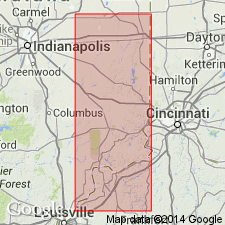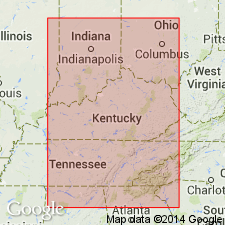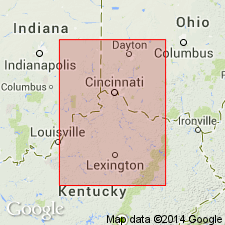
- Usage in publication:
-
- Dillsboro Formation
- Modifications:
-
- Named
- Dominant lithology:
-
- Limestone
- Shale
- AAPG geologic province:
-
- Cincinnati arch
Summary:
Named the Dillsboro Formation for Dillsboro, Dearborn Co., southeastern IN. Consists of highly fossiliferous, argillaceous limestone and calcareous shale. Thickness is 309 to 350 feet thick. Conformably overlies the Kope Formation and underlies the Saluda Formation. Faunal zones indicate that the Dillsboro is of Late Ordovician (Maysvillian and Richmondian) age.
Source: GNU records (USGS DDS-6; Reston GNULEX).

- Usage in publication:
-
- Dillsboro Formation*
- Modifications:
-
- Overview
- AAPG geologic province:
-
- Cincinnati arch
Summary:
The Dillsboro Formation in southeastern IN consists of mostly shale, but contains some highly fossiliferous, argillaceous limestone. Fossils include brachiopods, bryozoans, mollusks, arthropods, and echinoderms. Overlies the Kope Formation and underlies the Saluda Formation. It is proposed that former formations (ascending) Mount Hope, Fairmount, Bellevue, Corryville, Mount Auburn, Arnheim, Waynesville, and Liberty be used as informal biofacies within the Dillsboro. The upper part of the Dillsboro is lithologically and faunally similar to the Bull Fork Formation of OH and KY, its lateral equivalent in those states. The Dillsboro is of Late Ordovician (Maysvillian and early Richmondian) age.
Source: GNU records (USGS DDS-6; Reston GNULEX).

- Usage in publication:
-
- Dillsboro
- Modifications:
-
- Not used
- AAPG geologic province:
-
- Cincinnati arch
Summary:
The Cincinnatian Series is divided into five depositional sequences in this report, which correspond to lithostratigraphic units. The following stratigraphic names in KY should be abandoned as they have been applied to bodies of rock already named in downramp areas of OH and IN: Bardstown (=Lower Whitewater), Reba (=Oregonia), Stingy Creek (=Mount Auburn), Calloway Creek (=Bellevue), and Clays Ferry (=Fairview). The following units in KY, OH, and IN lump dissimilar facies and straddle sequence boundaries and therefore should be abandoned: Drakes, Ashlock, Dillsboro, Tanners Creek, and Bull Fork. Grant Lake has been defined in several different ways and consequently should be abandoned. Several units will be redefined at a later date, including the Upper Whitewater and the "Sunset" and "Saluda" of OH and IN. Formal naming of new lithostratigraphic units will follow further study.
Source: GNU records (USGS DDS-6; Reston GNULEX).

- Usage in publication:
-
- Dillsboro Formation*
- Modifications:
-
- Age modified
- AAPG geologic province:
-
- Cincinnati arch
Summary:
Age of Dillsboro Formation is refined to Cincinnatian (Maysvillian to early Richmondian).
Source: GNU records (USGS DDS-6; Reston GNULEX).
For more information, please contact Nancy Stamm, Geologic Names Committee Secretary.
Asterisk (*) indicates published by U.S. Geological Survey authors.
"No current usage" (†) implies that a name has been abandoned or has fallen into disuse. Former usage and, if known, replacement name given in parentheses ( ).
Slash (/) indicates name conflicts with nomenclatural guidelines (CSN, 1933; ACSN, 1961, 1970; NACSN, 1983, 2005, 2021). May be explained within brackets ([ ]).

